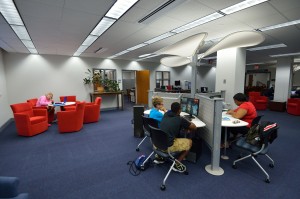 Patrons expressed a need, administrators listened, funds were provided and staff members pitched in to further enhance the J.D. Williams Library.
Patrons expressed a need, administrators listened, funds were provided and staff members pitched in to further enhance the J.D. Williams Library.
The result is an overhauled and enlarged study commons on the library’s first floor. The more user-friendly, updated facility includes six new group work spaces, 18 additional computer workstations and 30 new chairs, plus more electrical and cell phone charging outlets and a new printer.
The remodeled area has been named the Ainsworth Commons to honor donors Oscar Richard and Edith Wetzel Ainsworth. The couple’s estate provided close to $1 million for long-term library funding, with a small portion going toward the commons project and the remainder being placed in an endowment.
The expanded area opened this fall after the project began in spring 2012. The upgrade was based on a survey conducted among library patrons that generated more than 1,300 responses and served as a planning guide.
“We definitely listened to our undergraduate students, who made up 56 percent of the survey respondents,” said Julia Rholes, dean of university libraries. “It seems that, more than ever, our students – especially undergraduates – are being assigned projects where they work in groups, and we wanted to meet that need. They wanted more technology, more collaborative work spaces, group work arrangements and more comfortable seating.”
Two seniors in the business school have a set schedule with several of their peers to meet in the commons area for group study, which they have been doing all year. They agree that the upgraded Ainsworth Commons serves them well and are especially pleased with the new group work spaces.
“The way the area is arranged with separate cubicles makes a [calmer] atmosphere and gives us more privacy for studying as a group without disturbing others,” said Joslyn Matthews of Madison.
Edward Watkins of Madison agreed, saying, “I like it because of the privacy, but if we want to take a break individually and, say, read a book, we can go to the area close by where there are plush, comfortable chairs and relax.”
One of the most challenging aspects of the project was finding the space to expand.
“We have the same amount of space (in the building) we’ve always had, and we’re always looking for its best use,” Rholes said.
The area identified for conversion near the existing commons primarily housed metal cabinets full of microforms, DVDs, VHS materials and documents. While the design team, headed by Courtney Jones of UM Facilities Planning, completed its initial work, Stan Whitehorn, operations manager, organized the library’s teams, including the access services group that emptied the area and prepared it for paint.
“This was a large, comprehensive project that involved almost everyone employed in the library,” Whitehorn said. “Everyone pitched in because they knew what the end goal was: more and better study space for our patrons.”
Around 125 microforms cabinets were moved to an area previously occupied by state documents and government documents archives. At this point, the technical services and government documents teams pitched in to view each of the archival items and make a decision as to its eventual location, with most going to the Library Annex.
“One thing we deliberately do is keep looking at low-use materials that can be housed at remote storage locations and categorized so that we can easily get an item within a day at the request of any library patron,” Rholes said.
Besides expressing their needs, survey respondents also commented positively on the library’s current provisions, said Melissa Dennis, outreach and instruction librarian, who administered the survey.
“The overall satisfaction was very positive across the board,” Dennis said. “A lot of people commented on the changes we’ve made in recent years, especially in regard to facilities, and they just want more and more.”
The dean said that library patrons, especially graduate students who are doing independent research or simply want to study alone, enjoy the 100 study carrels and the graduate student study rooms that have been available for almost a decade.
“To know they’re in the building using our resources and they want more ways to use them is great,” Dennis added.